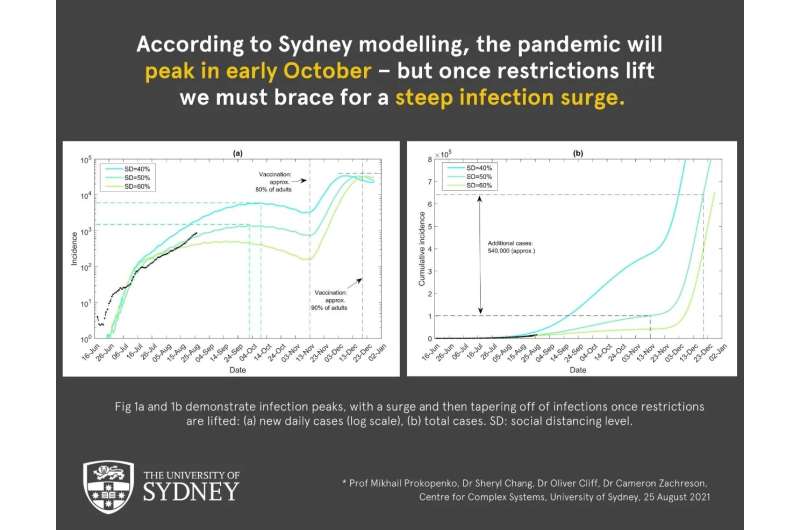
National modeling led by Centre for Complex Systems researchers shows that a pandemic peak is in sight, but we must brace for a surge of infections upon reopening when 80 percent of the adult population is vaccinated and restrictions are lifted.
New modeling shows COVID-19 cases will peak in Australia in early October, however social distancing restrictions must be maintained to prevent a steep rise in daily cases.
If restrictions are fully lifted when 80 percent of adults are vaccinated, infections across Australia may rapidly grow to 40,000 per day and exceed half a million cases in the month following the lift according to this latest modeling.
The modeling was led by Director of the University of Sydney’s Centre for Complex Systems Professor Mikhail Prokopenko, and his colleagues Dr. Sheryl Chang, Dr. Oliver Cliff and Dr. Cameron Zachreson.
The newly released extended projections use a model previously published on pre-print server arXiv.
The study found that daily COVID-19 case numbers are likely to continue to climb, reaching their lockdown peak in early October.
The modeling analyzed the period between 26 July until 25 August 2021 and found:
- Currently, social distancing is at around 50 percent. This is inadequate to contain the outbreak but gives Australians more time to get vaccinated before a lift in restrictions.
- Under current restrictions, by early October daily cases are estimated to peak between 1,500 and 6,000 per day across Australia.
At the current vaccination rollout rate, 80 percent of adults (65 percent of the total population) are projected to be vaccinated by mid-November, at which point social distancing restrictions are expected to be removed, according to the national plan.
By the end of the year, the researchers’ model assumes that a continuing vaccination rollout will reach 90 percent of adults (about 75 percent of the total population), which Professor Prokopenko’s team believes is a feasible and sensible target.
If restrictions are removed once 80 percent of adults are vaccinated, new daily cases will rapidly grow and may approach 40,000 per day across Australia. The total number of Australians infected in the month following reopening may exceed half a million, even with continued testing, tracing, isolation, quarantine and international travel restrictions.
Despite this immediate post-lockdown surge, pandemic growth is expected to slow from mid-December, with 75 percent of the population vaccinated and natural immunity developed by three to five percent of the entire population by the end of the year.
“Our extended projections suggest that Delta cases will initially peak in early October and will begin to drop off as more of the population is vaccinated. However, consistent adherence to social distancing is important to prevent a sharp peak in cases,” said Professor Prokopenko.
“Although it is encouraging that more people are being vaccinated, we can expect to see a rapid increase in cases when we exit the lockdown. In fact, our modeling suggests the worst is yet to come if the restrictions are removed too soon and too abruptly.
“The clear take away is this—with increasing vaccinations there is a path out of the current outbreak, but as a society we can either choose to land softly or come to a dramatic crash landing.
“This will depend on the community continuing its high vaccine uptake, people maintaining social distancing over the coming months, and our healthcare system preparing and bolstering itself to meet the surge of hospitalisations which will come after the lockdown.
“Although the current situation is frustrating, the lockdown end is now in sight, and we must not lose our focus until it is safe to do so. As Mahatma Gandhi famously asserted, ‘to lose patience is to lose the battle’ – this is a warning we must now all heed.”
About the modeling:
- The study was modeled up until 25 August, whereas the mid-term model projections are limited by the end of 2021.
- Using an agent-based model, the researchers explored a feasible range of both non-pharmaceutical interventions (case isolation, home quarantine, school closures, social distancing) and pharmaceutical interventions (progressive vaccination rollout).
- Children younger than 16 years of age are not assumed to be vaccinated. The model accounts for an increased fraction of symptomatic cases in children and the basic reproductive number of 6.2 (see S5 at arxiv.org/abs/2107.06617).
- Case isolation, home quarantine, and international border closures are assumed to remain in place until 90 percent of adults are vaccinated (projected by the model to occur at the end of the year).
- The pre-print paper has not been peer reviewed and is submitted to a leading journal for peer review and publication.
- The model it uses was published last year in peer-reviewed journal Nature Communications, and a follow-up study of vaccination uptake was published in The Lancet Regional Health—Western Pacific.
Source: Read Full Article
